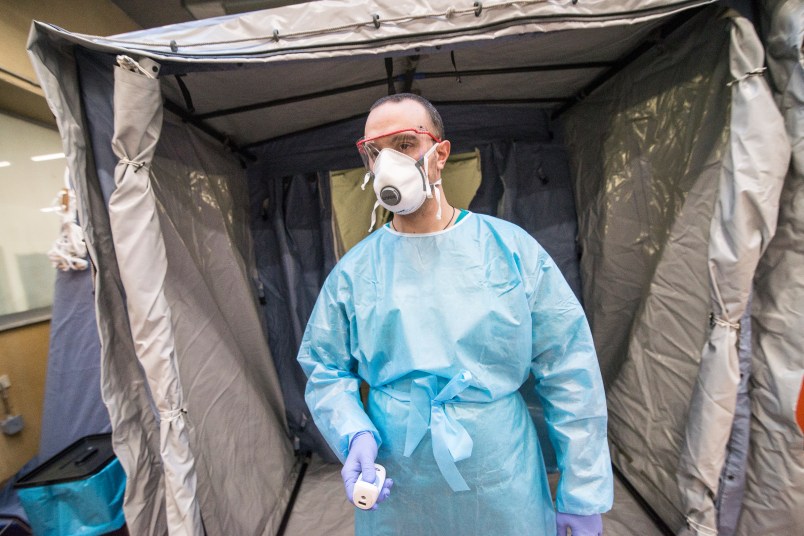It could be a perfect storm.
The coronavirus has sparked worries of pandemic, with hundreds of thousands of people around the country potentially infected in a worst-case scenario.
Compounding the problem is that some of the hospitals that most frequently treat the poorest, sickest, and oldest patients — in other words, those most susceptible to suffering from serious COVID-19 symptoms — are already in a precarious position.
Outbreaks threaten to collide with the little-noted but significant rural health care crisis that the U.S. has undergone over the past decade.
Since 2010, 126 rural hospitals have closed. And according to statistics from the Chartis Center for Rural Health, 47 percent of rural hospitals in the U.S. were in the red in 2019.
Coronavirus presents a unique risk to an already fragile rural health-care system: in severe cases, the illness requires intensive, long-term care that takes up beds and staff, while the level of contagion could quickly overwhelm the capacity of smaller, rural providers.
“A situation like that would really tax our resources,” Frank Tenorio, an assistant administrator and infection prevention officer of the 10-bed Guadalupe County Hospital in eastern New Mexico, told TPM.
Absent aid from the federal government, experts told TPM, the outbreak could strain many rural hospitals that are already financially on the brink.
“If the pandemic becomes as serious as some believe, and hits rural areas in particular, it could exacerbate the rural crisis,” said Duane Morris partner Delphine O’Rourke, who advises hospitals on emergency planning. “Who is actually going to pay for the care?”
Rural fragility
Much of the problem comes down to the fact that rural hospitals operate on extremely tight margins, and serve poorer and sicker parts of the U.S. population than urban providers. These hospitals — like Tenorio’s in New Mexico — predominantly rely on Medicare and Medicaid to reimburse patients, tightening the margins.
Maggie Elehwany, vice president at the National Rural Health Association, told TPM that policy changes over the years — including a provision of recent accounting standard that cut into the amount of bad debt that hospitals can write off and 2 percent cuts in Medicare reimbursement — have made it significantly more difficult to stay afloat.
“What we found was when states didn’t expand Medicaid, we ended up with people in rural America getting sick and not being covered,” Elehwany said. “And even if they did have insurance, what we found was that private insurance plans on the exchanges weren’t working in rural America.”
The way in which government health-care plans work in rural America presents its own problems.
Gerald Kominski, a UCLA professor who studies health-care finances, pointed out to TPM that Medicare and Medicaid pay the least to providers, in that order, ahead of no insurance at all. Private insurance pays the most.
The reliance on government insurance — nearly two thirds of days spent in hospitals in rural American are reimbursed by Medicare — renders these providers’ finances far more precarious.
“Nobody is gonna be making profits on these, it’s not the role of the federal programs,” Elehwany said. “So you need a proper private insurer mix, and that just doesn’t happen in most of rural America.”
Corona collision
What was already a crisis in rural health threatens to collide head-on with growing outbreaks of coronavirus.
Part of this has to do with the kinds of illnesses that occur in poorer, rural areas. Cases of chronic respiratory disease, for example, are 75 percent higher in rural areas than urban, while the proportion of people 65 and older is far higher.
Statistics from South Korea and other areas hit by the outbreak suggest that older patients are far more at risk of suffering serious symptoms from the illness. The CDC says that older people are “twice as likely” to have serious symptoms.
According to a Seattle-area emergency room doctor stationed at hospitals treating a coronavirus outbreak, most of the patients coming in have been older and sicker.
“This is following a pattern where the old and infirm are getting sicker and having worse outcomes,” the doctor said.
Elehwany pointed out that the profile matches that of rural areas — “we can expect a higher concentration of deaths if there are outbreaks in rural communities. Many nursing homes are affiliated with the local hospital, for example.”
COVID 19 may worsen the financial burden in other ways as well. Apart from the reliance on lesser paying government insurance programs, some hospitals may have to cut back on services likes elective surgeries that typically bring in cash.
“To the extent that there are uninsured patients who show up with the disease, you can’t turn them away and say, ‘seek care elsewhere.’ But they’re uninsured, so that’s a financial stressor on the provider,” Kominski, the UCLA professor said.
He added that one proposal — under which the federal government would “cover the costs of people who are uninsured” and have coronavirus — could alleviate the burden on rural providers.
But for Tenorio, the rural New Mexico assistant administrator, the problems are less financial than material.
He told TPM that in the event of a large outbreak, his hospital would discharge whatever patients could be discharged to open up additional room, before using a nearby assisted-living facility as spillover.
Elehwany emphasized that these hospitals “are stressed already simply because of the narrow financial margins.”
“If we don’t have stable rural hospitals, it’s gonna be a significant crisis out there.”






